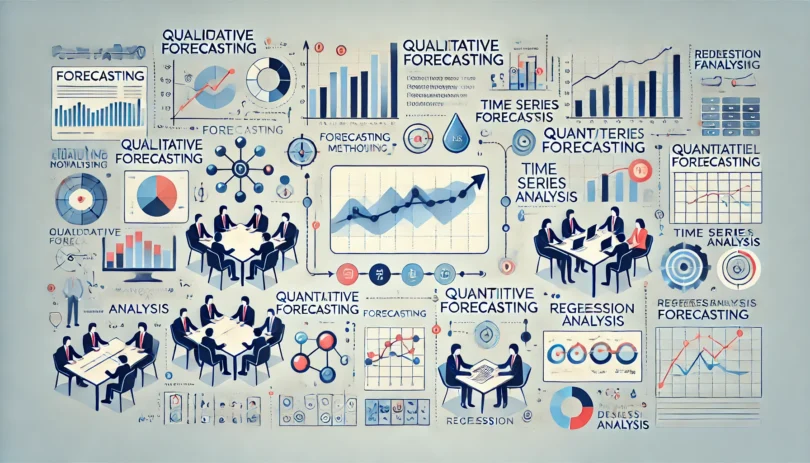Introduction
The success of cash flow forecasting largely depends on the methods used to generate projections. Forecasting methods can range from simple techniques based on historical data to advanced models that utilize predictive analytics and artificial intelligence. Selecting the right method depends on the organization’s needs, data availability, and complexity of cash flow dynamics. This chapter explores the various forecasting methods, their applications, advantages, and limitations.
- Overview of Forecasting Methods
Forecasting methods can be broadly categorized into qualitative and quantitative approaches. Qualitative methods rely on expert judgment and intuition, while quantitative methods use mathematical and statistical models.
- Qualitative Forecasting Methods
2.1 Expert Judgment
- Definition: Relies on insights and experience from financial managers, industry experts, or internal stakeholders.
- Applications:
- Useful for new businesses or markets with limited historical data.
- Effective in forecasting unique, non-repetitive cash flow events.
- Advantages:
- Easy to implement and adapt.
- Incorporates industry-specific knowledge.
- Limitations:
- Subjective and prone to bias.
- Less accurate for complex or large-scale forecasts.
2.2 Delphi Method
- Definition: A structured approach where multiple experts provide forecasts independently, and their inputs are iteratively refined to reach a consensus.
- Applications:
- Strategic forecasting for long-term cash flow planning.
- Advantages:
- Reduces individual bias by aggregating diverse opinions.
- Encourages collaborative decision-making.
- Limitations:
- Time-consuming and resource-intensive.
- Requires a group of knowledgeable participants.
- Quantitative Forecasting Methods
3.1 Time Series Analysis
- Definition: Uses historical data to identify patterns and trends that can predict future cash flows.
- Applications:
- Forecasting recurring cash inflows, such as monthly sales revenue.
- Techniques:
- Moving averages.
- Exponential smoothing.
- Seasonal decomposition.
- Advantages:
- Ideal for stable, cyclical cash flows.
- Provides objective, data-driven forecasts.
- Limitations:
- Limited adaptability to sudden changes or anomalies.
- Requires sufficient historical data.
3.2 Regression Analysis
- Definition: Examines relationships between variables (e.g., sales and cash flow) to predict cash inflows and outflows.
- Applications:
- Identifying key drivers of cash flow, such as sales, expenses, or external economic factors.
- Advantages:
- Accounts for multiple variables influencing cash flow.
- Useful for identifying trends and correlations.
- Limitations:
- Requires advanced statistical knowledge.
- Assumes relationships between variables remain constant over time.
3.3 Simulation Models
- Definition: Uses statistical techniques (e.g., Monte Carlo simulations) to model potential outcomes based on a range of inputs.
- Applications:
- Testing the impact of uncertain factors, such as exchange rates or commodity prices, on cash flow.
- Advantages:
- Provides a probabilistic view of possible outcomes.
- Useful for risk assessment and contingency planning.
- Limitations:
- Computationally intensive.
- Requires high-quality data for accuracy.
3.4 Direct Forecasting
- Definition: Tracks actual expected inflows and outflows, often at a transactional level.
- Applications:
- Short-term liquidity management, such as ensuring sufficient funds for payroll.
- Advantages:
- High accuracy for immediate cash flow needs.
- Simple to understand and implement.
- Limitations:
- Not suitable for long-term planning.
- Labor-intensive for large organizations with complex transactions.
3.5 Indirect Forecasting
- Definition: Derives cash flow projections from broader financial statements, adjusting net income for non-cash items and changes in working capital.
- Applications:
- Long-term strategic planning.
- Advantages:
- Links cash flow to broader financial performance.
- Effective for high-level planning.
- Limitations:
- Less granular and precise for short-term needs.
- Depends on accurate financial statement data.
- Hybrid Forecasting Methods
4.1 Combining Direct and Indirect Approaches
- Purpose: Leverages the granularity of direct methods for short-term forecasts and the broader perspective of indirect methods for long-term planning.
- Applications:
- Balancing operational and strategic cash flow needs.
- Advantages:
- Provides comprehensive visibility across time horizons.
- Improves overall accuracy.
- Limitations:
- Requires robust data integration and coordination.
4.2 Machine Learning and AI Models
- Definition: Uses algorithms to analyze vast datasets, identify patterns, and continuously refine forecasts.
- Applications:
- Real-time cash flow monitoring and prediction.
- Detecting anomalies in cash flow patterns.
- Advantages:
- Adapts to changing conditions and data inputs.
- Reduces manual effort and error rates.
- Limitations:
- Requires expertise in AI and data science.
- Can be expensive to implement.
- Choosing the Right Forecasting Method
5.1 Factors to Consider
- Time Horizon:
- Use direct methods for short-term needs and indirect methods for long-term planning.
- Data Availability:
- Choose methods that align with the quality and quantity of available data.
- Complexity:
- Simpler methods for straightforward cash flows; advanced models for complex or volatile scenarios.
- Organizational Needs:
- Tailor methods to specific goals, such as operational efficiency or strategic growth.
5.2 Example Scenarios
- Retailer: Uses time series analysis for daily cash flow forecasting during peak seasons.
- Tech Startup: Leverages machine learning to manage cash flow amid rapid growth and uncertainty.
- Multinational Corporation: Combines regression analysis with scenario modeling to forecast cash flows across regions.
- Emerging Trends in Forecasting Methods
6.1 Integration of Big Data
- Advanced methods incorporate diverse data sources, such as market trends, social sentiment, and economic indicators.
6.2 Real-Time Analytics
- Real-time forecasting enables organizations to adjust cash flow projections dynamically based on live data.
6.3 Blockchain for Data Transparency
- Blockchain technology enhances the accuracy and reliability of forecasting inputs by providing immutable transaction records.
Conclusion
Cash flow forecasting methods have evolved significantly, offering organizations a wide range of tools to suit different needs and complexities. By understanding the strengths and limitations of each method, businesses can develop forecasts that are accurate, actionable, and aligned with their goals. Subsequent chapters will explore best practices for implementing these methods and ensuring their effectiveness in real-world scenarios.








Leave a Comment
You must be logged in to post a comment.